The Microsoft Surface Pro (2017) Review: Evolution
by Brett Howse on June 15, 2017 9:00 AM ESTGraphics Performance
With the Core i7-7660U, we finally get a chance to look at the Intel Iris Plus Graphics 640 in a notebook. On a typical U series Intel Core processor, there are 24 execution units (EUs) available, but the Iris Plus doubles that to 48. Despite having the same TDP, having twice as many EUs running should still be a big boost to performance, as even if they need to throttle, there are twice as many, so they can run slow and wide and still fit in the TDP. The base frequency for the graphics is 300 MHz, with a 1.1 GHz boost frequency.
The addition of 64 MB of eDRAM is also a large benefit to graphics, which needs a lot more memory bandwidth than the CPU, and having this extra eDRAM as a cache for the GPU is a big benefit to the Iris Plus graphics.
In the graphs below, make note that the Dell XPS 15 has a GTX 960M graphics card, which should win pretty handily, but the Surface Book has a smaller GT 940M with 2 GB of GDDR5, so it will be interesting to see the performance difference between the integrated Iris Plus Graphics 640, and a discrete entry-level GPU.
3DMark
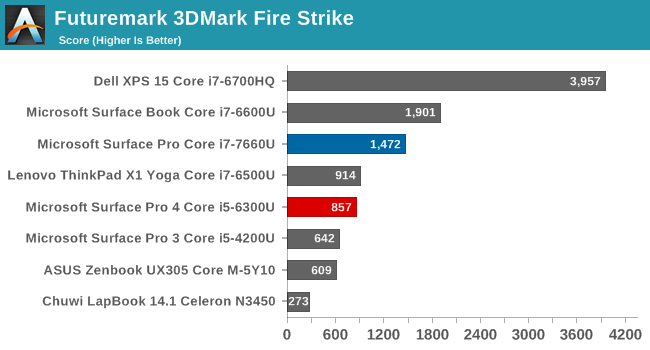
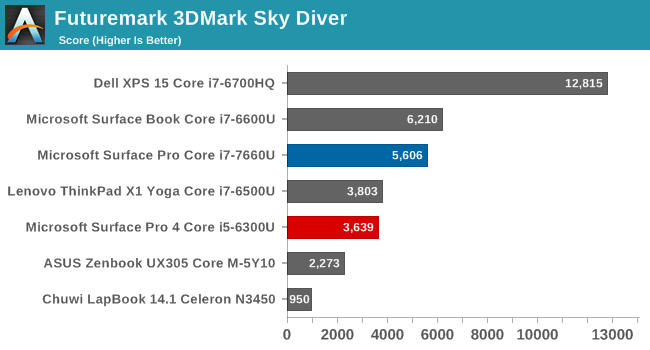


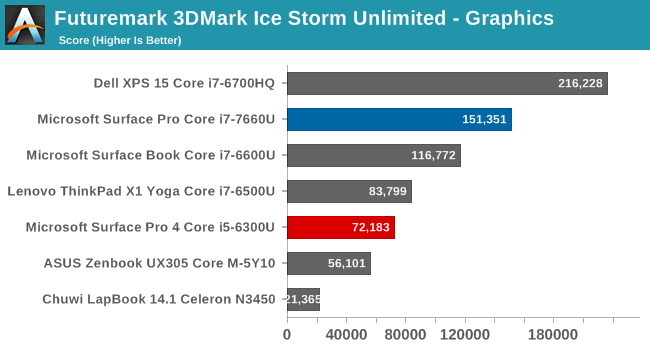
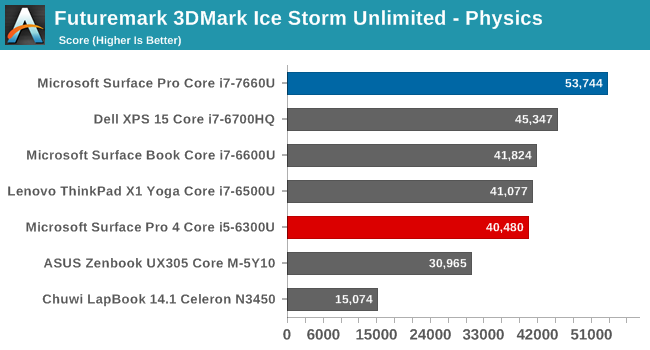
Futuremark’s 3DMark continues to be developed, and new tests have been added for higher end systems, but for our purposes on this review, the normal results will do just fine. Each of the tests move from quality to performance, with Fire Strike being the most demanding, and Ice Storm Unlimited being a smartphone or tablet test. The GT 940M in the Surface Book still manages to hold an edge on the more graphically demanding tests, but is then surpassed as the workload gets easier, and the test becomes more CPU bound. Compared to the non-Iris Ultrabooks though, the i7-7660U delivers a lot more performance.
GFXBench
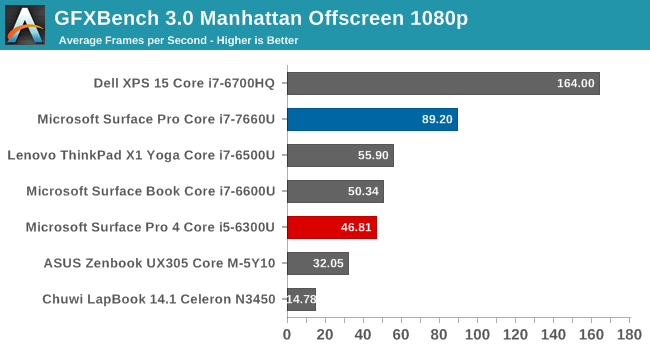

Another synthetic, Kishonti’s GFXBench also continues to evolve, with new tests being added to provide more stressful tests than the older T-Rex and Manhattan ones. Since we don’t have any comparison data, for now we’ll stick with the older tests while we fill out the data gaps. The Intel Iris graphics pull out a hefty lead here.
Dota 2
Valve’s Dota 2 online area game continues to be our go-to game for testing systems with lower end graphics, since it has a low barrier of entry, and is quite playable at low settings even on a system with integrated graphics.
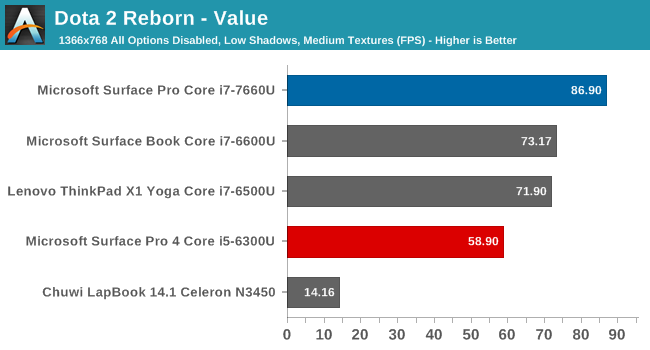
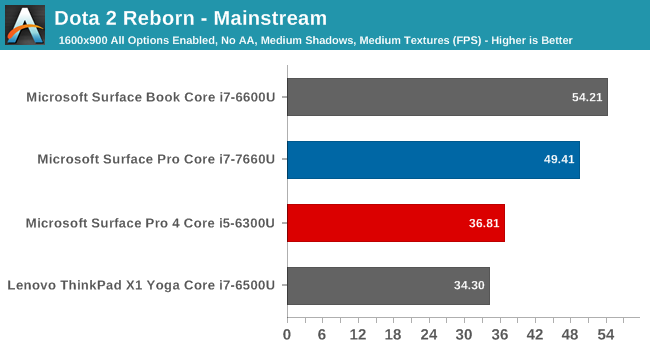
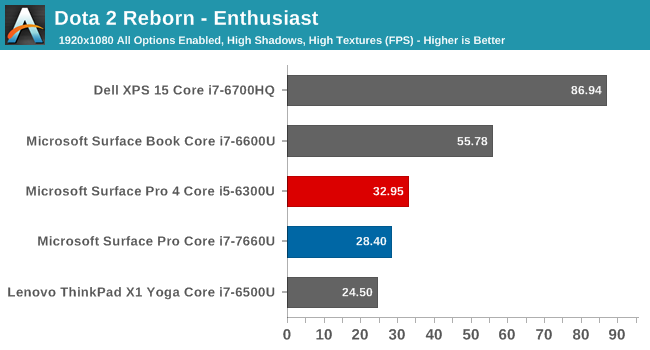
Here the Iris Plus Graphics do not bring the kind of improvement that would have been hoped for. At lower settings, they are very capable, and the extra CPU speed from the i7-7660U helps break the CPU bound barrier of the other systems, but once the graphics are turned up, the U series chip runs into the thermal barrier of only having a 15-Watt TDP. Compared to the Microsoft Surface Book, with it’s discrete GT 940M GPU, there’s really no contest, since that GPU alone would have 20-30 Watts of TDP available to it. The Iris does allow a lot more graphics potential, but for longer duration requirements, it may not offer much of an upgrade.
Graphics Conclusion
It’s great to finally be able to test a system with a U Series CPU and Iris graphics, and the results are quite impressive. It’s not quite up to par with even a low-end discrete GPU, but compared to the other integrated GPUs available in the other Ultrabooks, the Iris really brings the performance up a step. For light gaming, it should work well, but the extra eDRAM can help out on practically any task. The extra EUs available would also be of benefit to any productivity app that can leverage the GPU for some of its compute.
Storage Performance
PCIe SSDs have been the name of the game for the last couple of generations of Ultrabooks, but they’ve generally been shipping in the M.2 form factor. Microsoft has gone a different route with the new Surface Pro, by moving to a much smaller BGA SSD in the Samsung PM971.
The benefits of going this route are mostly packaging. The BGA SSD is significantly smaller than any M.2 SSD, especially the 2280 versions that are the most common. The drive is also most likely more energy efficient than the fastest SSDs available today, which should help with battery life.
There is likely only one downside to the PM971 BGA SSD, and that is performance. While still much faster than a SATA SSD, the PM971 is limited to a PCIe 3.0 x2 link, which is going to impact the maximum read and write speeds.
As you can see in the CrystalDiskMark test, the maximum read speed is well under something like a Samsung SM961. This may seem like bad news, but in fact the PM971 actually outperforms the same size PM951 drive which was easily the most popular SSD found in Ultrabooks until recently. The PM971 is 48 layer TLC NAND, with reasonable write speeds, and other than the lowered maximums created by the PCIe link being x2 instead of x4, the performance is quite good.
When you look at a device like the Surface Pro, where space is at a premium, these are the kinds of compromises that make sense when you consider that they’ve increased the battery capacity by 15%, and despite going with a compact SSD, they’ve still increased performance over the outgoing model assuming it had a PM951, which it seemed most did.


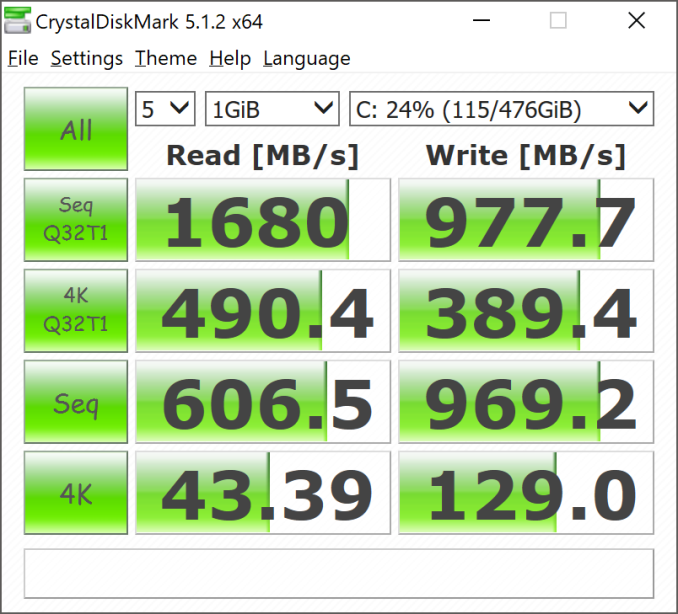








124 Comments
View All Comments
Icehawk - Thursday, June 15, 2017 - link
Have they fixed multi-monitor output yet? I support 11 various Surface devices and they are terrible about switching modes/monitors. The stock screen's resolution is unusable for most my users with everything so tiny.gerz1219 - Thursday, June 15, 2017 - link
This is my one complaint with my Surface Book -- it gets all wonky when I plug it into the dock and drive two 1440p monitors, then disconnect it and use it as a laptop. The interface doesn't snap back to normal and I usually have to reboot to get the text rendering properly again. Sometimes the dock automatically switches the resolution properly when plugged in, and sometimes it doesn't.This seems like something that should be fixable with a simple Windows update, but I was still having issues as of the last update.
Brett Howse - Thursday, June 15, 2017 - link
They've made advances here in the last couple of Windows 10 Updates in particular. Due to the short amount of time we've had to work with the device, I've not hooked it up to an external display yet, but I can.melgross - Thursday, June 15, 2017 - link
I am so tired of reading about the success of the Surface Pro, when it's clearly been close to a failure.Consider that Microsoft sold about $4.2 billion worth of products in the Surface division during 2016. That includes Surface Pro, Surface 3, Surfacebooks, keyboards, etc. the most popular Surface Pro is the i5 256GB 8GB RAM model. Most Surface Pros are sold with the keyboard.
You can do some math. That makes the average Surface Pro sale about $1,450. Doing some very simplistic work, ignoring everything else, and pretending that every sale is a Surface Pro. We get a maximum of 2.9 million Surface Pros sold in 2016. The real numbers will be lower once Surfacebooks and Surface 3 models are subtracted out.
That's not a lot. I read in Computerworld, Information week and other places, that the biggest buyers of Surface Pro devices are IT departments, where it fits within their Microsoft based environment.
I know this isn't popular to say here, but it's straight numbers. It's not a lie. This line has never really been successful, despite the joyful writing I see about it. The reality is something else. And now, the last quarter had a 26% drop in sales for the division, so tablet retrenchment has caught up with them. That's likely one reason why Microsoft has slowed down. I doubt this has ever been profitable for them.
Brett Howse - Thursday, June 15, 2017 - link
The success is how it's created a new category of devices. It also happens to be the best device in that category. It's caused everyone in the industry to make a similar, and sometimes, identical, device, but without the build quality and polish.melgross - Thursday, June 15, 2017 - link
I'd like to know just how successful that entire category is. I never see one of the things anywhere. I've never met anyone who has one. I think there's more talk than action.soliloquist - Friday, June 16, 2017 - link
Surface Revenue:2015 over 2014 was an increase of 65%
2016 over 2015 was an increase of 13%
Given that the PC market as a whole over this time was stagnant or decreasing, for Microsoft to produce these gains is pretty significant.
Source: Microsoft 2016 Annual Report
https://www.microsoft.com/investor/reports/ar16/in...
As for the unit volume, with a price close to $1,500 (or more), it is expected that number of units sold would be significantly less than other tablets.
tipoo - Monday, June 19, 2017 - link
I'm sure it's a matter of where one lives. My city isn't that big but I still see a few Surfaces in coffee shops and airports.
amdwilliam1985 - Thursday, June 15, 2017 - link
I see most students on campus(graduate school) are either using MBA or Surface Pro 3/4 now. This says a lot, consider only a couple years ago when most people are using MBA.You're right about IT department buying them, our company has bought a few of them as test drivers. I can see us getting more as the trial has been mostly smooth so far.
Hurr Durr - Friday, June 16, 2017 - link
>selling 3 mil devices>not a success because melgross says so
Woe to Microsoft.